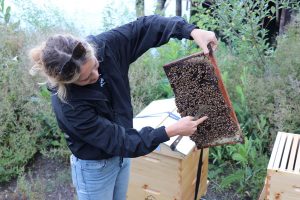A sustainable port is one that supports healthy ecosystems. The Port of Vancouver operates within an ecologically rich environment that is home to diverse aquatic and terrestrial species. We know port operations and infrastructure development can cause habitat loss and degradation, which in turn can affect biodiversity and habitat productivity. This is why we run a suite of programs and initiatives aimed at mitigating potential impacts of port-related activity, with the goal of preserving and protecting our natural environment for generations to come.
Protecting local wildlife and aquatic species
From animals to insects and plants to biofilm, an ecosystem is only as healthy as the species that live in it. At the port authority, our environmental scientists are hard at work on measures to help protect the wide variety of species that call the federal lands and waters of the Port of Vancouver home. These efforts include:
- Supporting species at risk: Under the Species at Risk Act, species identified as “at risk” are legally protected from disturbance on federal lands. There are a number of these species within our jurisdiction—such as sturgeon, bats, bees and turtles—so we work to ensure the impacts of port-related activities on their populations are as limited as possible. The port authority-led Enhancing Cetacean Habitat and Observation (ECHO) Program, which uses world-leading science to help reduce the impact of the shipping industry on at risk southern resident killer whales, is just one example of our efforts.
- Working together to reduce underwater noise: We take a collaborative approach to tackling underwater noise, working with port tenants and users as well as the broader port community to increase their understanding and help them take action to reduce underwater noise
- Preventing the spread of invasive species: We are focused on curbing the introduction and spread of invasive plant species throughout our jurisdiction, which is considered the biggest threat to native biodiversity after habitat loss
Managing port lands and waters responsibly
We take our role as the steward of the lands and waters that make up the Port of Vancouver very seriously. Because terminal operations, infrastructure development and the shipping of goods through local waters can have impacts on the health of our natural environment, we take steps to maintain healthy ecosystems throughout our jurisdiction, which include:
- Keeping our waterways clean: Together with partners we monitor and manage local water quality to prevent harm to wildlife and contamination of local water sources
- Managing land and contaminated sites: We are diligent about holding our tenants responsible for cleaning up and restoring any contamination they have contributed to that occurs on the sites they lease at the Port of Vancouver
- Offsetting port development though habitat enhancement: Through our Habitat Enhancement Program (HEP), we work to maintain a balance between a healthy environment and future port development by proactively creating, enhancing and rehabilitating habitats that benefit our region’s fish and wildlife
|
|

